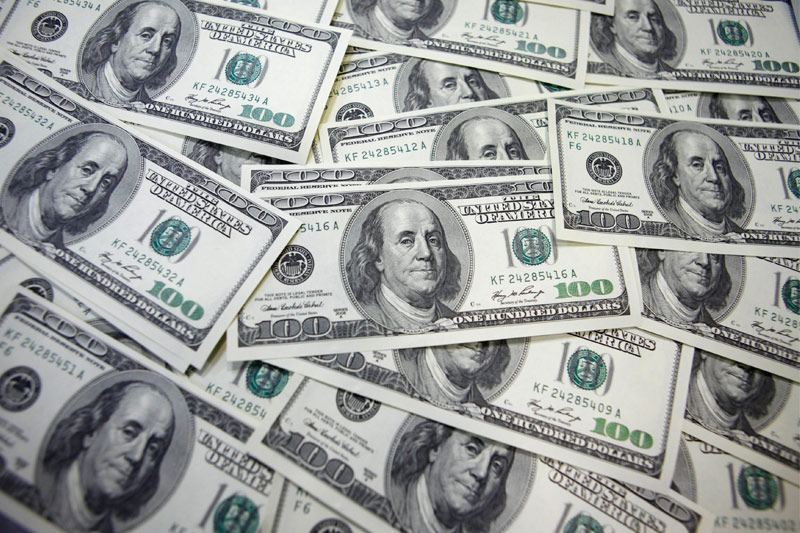Investing.com - The U.S. dollar remained broadly higher against its major counterparts on Thursday, after official data showed that U.S. jobless claims fell to the lowest level since February 2008 last week, underlining the view that the U.S. economic recovery is gathering momentum.
During European afternoon trade, the dollar was lower against the euro, with EUR/USD shedding 0.35% to hit 1.3169.
The euro fell against the greenback earlier after preliminary data showed that manufacturing activity in the euro zone slumped unexpectedly in March, while service sector activity in the region declined to the lowest level in four months, sparking concerns that the region’s economy is sliding back into a recession.
The greenback was also higher against the pound, with GBP/USD dropping 0.43% to hit 1.5804.
Sentiment on the pound was hit earlier after official data showed that U.K. retail sales posted the largest drop in nine months in February and were revised down for the previous month.
But the greenback was lower against the yen, with USD/JPY losing 0.38% to hit 83.09.
Government data showed earlier that Japan’s trade balance swung into a surplus of JPY32.92 billion in February, confounding expectations for a deficit of JPY120 billion following the downwardly revised deficit of JPY1.47 trillion reported in January.
The dollar was higher against the Swiss franc, with USD/CHF adding 0.34% to hit 0.9152.
Elsewhere, the greenback posted strong gains against its Canadian, Australian and New Zealand cousins, with USD/CAD advancing 0.65% to hit 0.9986, AUD/USD falling 0.80% to hit 1.0373 and NZD/USD slumping 0.89% to hit 0.8082.
In Canada, official data showed that retail sales rose by a seasonally adjusted 0.5% in January, disappointing expectations for a 1.8% increase, while core retail sales declined 0.5%, against expectations for a 0.5% gain.
Sentiment on the growth linked dollars was also hit on Thursday, after a report showed that China’s HSBC manufacturing index contracted for a fifth successive month in March, as new orders fell.
The dollar index, which tracks the performance of the greenback versus a basket of six other major currencies, was up 0.34% to hit 80.08.
The U.S. Department of Labor said the number of people who filed for unemployment assistance in the U.S. last week fell to a seasonally adjusted 348,000, beating expectations for a decline of 3,000 to 350,000.
The previous week’s figure was revised up to 353,000 from 351,000.
Jobless claims have remained below 400,000, a level historically associated with an improving labor market, in 19 of the past 21 weeks.
During European afternoon trade, the dollar was lower against the euro, with EUR/USD shedding 0.35% to hit 1.3169.
The euro fell against the greenback earlier after preliminary data showed that manufacturing activity in the euro zone slumped unexpectedly in March, while service sector activity in the region declined to the lowest level in four months, sparking concerns that the region’s economy is sliding back into a recession.
The greenback was also higher against the pound, with GBP/USD dropping 0.43% to hit 1.5804.
Sentiment on the pound was hit earlier after official data showed that U.K. retail sales posted the largest drop in nine months in February and were revised down for the previous month.
But the greenback was lower against the yen, with USD/JPY losing 0.38% to hit 83.09.
Government data showed earlier that Japan’s trade balance swung into a surplus of JPY32.92 billion in February, confounding expectations for a deficit of JPY120 billion following the downwardly revised deficit of JPY1.47 trillion reported in January.
The dollar was higher against the Swiss franc, with USD/CHF adding 0.34% to hit 0.9152.
Elsewhere, the greenback posted strong gains against its Canadian, Australian and New Zealand cousins, with USD/CAD advancing 0.65% to hit 0.9986, AUD/USD falling 0.80% to hit 1.0373 and NZD/USD slumping 0.89% to hit 0.8082.
In Canada, official data showed that retail sales rose by a seasonally adjusted 0.5% in January, disappointing expectations for a 1.8% increase, while core retail sales declined 0.5%, against expectations for a 0.5% gain.
Sentiment on the growth linked dollars was also hit on Thursday, after a report showed that China’s HSBC manufacturing index contracted for a fifth successive month in March, as new orders fell.
The dollar index, which tracks the performance of the greenback versus a basket of six other major currencies, was up 0.34% to hit 80.08.
The U.S. Department of Labor said the number of people who filed for unemployment assistance in the U.S. last week fell to a seasonally adjusted 348,000, beating expectations for a decline of 3,000 to 350,000.
The previous week’s figure was revised up to 353,000 from 351,000.
Jobless claims have remained below 400,000, a level historically associated with an improving labor market, in 19 of the past 21 weeks.
